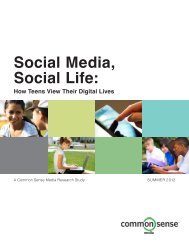Higher Education: Gaps in Access and Persistence Study
Higher Education: Gaps in Access and Persistence Study
Higher Education: Gaps in Access and Persistence Study
You also want an ePaper? Increase the reach of your titles
YUMPU automatically turns print PDFs into web optimized ePapers that Google loves.
Many studies have documented the associations between student background <strong>and</strong> educational outcomes (e.g., high<br />
school graduation rates <strong>and</strong> postsecondary enrollment, persistence, <strong>and</strong> atta<strong>in</strong>ment rates). Demographic factors known<br />
to be l<strong>in</strong>ked to these outcomes <strong>in</strong>clude socioeconomic status <strong>in</strong>dicators (e.g., poverty, family <strong>in</strong>come, <strong>and</strong> parents’<br />
education), parental <strong>in</strong>volvement, student disabilities, <strong>and</strong> native language. Chapter 1 exam<strong>in</strong>es some of these <strong>in</strong>dicators<br />
<strong>and</strong> analyzes group differences by sex <strong>and</strong> race/ethnicity.<br />
As a case <strong>in</strong> po<strong>in</strong>t, poverty poses a serious challenge to a child’s ability to succeed <strong>in</strong> school <strong>and</strong> its prevalence is<br />
markedly higher among certa<strong>in</strong> racial/ethnic groups than <strong>in</strong> others. Research has suggested that liv<strong>in</strong>g <strong>in</strong> poverty <strong>in</strong><br />
early childhood is associated with lower than average academic performance that extends through elementary <strong>and</strong><br />
high school <strong>and</strong> can lead to lower than average rates of school completion (Black, Hess, <strong>and</strong> Berenson-Howard 2000;<br />
Brooks-Gunn <strong>and</strong> Duncan 1997; Campbell et al. 2001; Entwisle, Alex<strong>and</strong>er, <strong>and</strong> Olson 2005; Lee <strong>and</strong> Burkman<br />
2002). Further, grow<strong>in</strong>g up <strong>in</strong> poverty is negatively correlated with children’s physical health, as well as their work<strong>in</strong>g<br />
memory, possibly due to the chronic psychological stress of liv<strong>in</strong>g <strong>in</strong> poverty (Evans <strong>and</strong> Schamberg 2009).<br />
Other factors—such as parental education levels—have also been l<strong>in</strong>ked to child outcomes such as educational<br />
experience, atta<strong>in</strong>ment, <strong>and</strong> academic achievement. For example, positive associations have been found between<br />
children with highly educated mothers <strong>and</strong> their rates of participation <strong>in</strong> early childhood education programs <strong>and</strong><br />
home literacy activities (Planty et al. 2009). In an earlier report that exam<strong>in</strong>ed the postsecondary experiences of firstgeneration<br />
college students (college students whose parents had never enrolled <strong>in</strong> postsecondary education), Nunez<br />
<strong>and</strong> Cuccaro-Alam<strong>in</strong> (1998) found that among beg<strong>in</strong>n<strong>in</strong>g postsecondary students <strong>in</strong> 1989–90, first-generation college<br />
students persisted <strong>in</strong> postsecondary education <strong>and</strong> atta<strong>in</strong>ed credentials at lower rates than their non-first-generation<br />
counterparts. This f<strong>in</strong>d<strong>in</strong>g held for students at 4-year <strong>in</strong>stitutions as well as public 2-year <strong>in</strong>stitutions. Even when<br />
controll<strong>in</strong>g for many of the characteristics that dist<strong>in</strong>guish first-generation college students from their peers, such as<br />
socioeconomic status, <strong>in</strong>stitution type, <strong>and</strong> attendance status, first-generation student status still had a negative effect<br />
on persistence <strong>and</strong> atta<strong>in</strong>ment.<br />
Extensive research exists on the importance of parental <strong>in</strong>volvement <strong>in</strong> children’s education (e.g., Jordan, Snow, <strong>and</strong><br />
Porche 2000; Starkey <strong>and</strong> Kle<strong>in</strong> 2000; Gutman <strong>and</strong> Midgley 2000; Shumow <strong>and</strong> Miller 2001). Children whose parents<br />
are <strong>in</strong>volved <strong>in</strong> their schools by do<strong>in</strong>g such th<strong>in</strong>gs as attend<strong>in</strong>g school events <strong>and</strong> back-to-school nights or volunteer<strong>in</strong>g<br />
are more likely to do well <strong>in</strong> school, to rema<strong>in</strong> <strong>in</strong> school, <strong>and</strong> to exhibit fewer behavioral problems than children whose<br />
parents are not <strong>in</strong>volved.<br />
Limited English proficiency cont<strong>in</strong>ues to be associated with educational outcomes for nonnative speakers of English<br />
<strong>in</strong> the United States. Studies have demonstrated that even with additional educational support, students who have<br />
difficulty speak<strong>in</strong>g English often have persistently lower academic achievement (e.g., on achievement tests <strong>in</strong> read<strong>in</strong>g<br />
<strong>and</strong> mathematics) <strong>and</strong> educational atta<strong>in</strong>ment than native English speakers (Brady, Ow<strong>in</strong>gs, <strong>and</strong> Qu<strong>in</strong>n 1992; Kle<strong>in</strong><br />
et al. 2004). In addition, language difficulties may contribute to the significantly higher dropout rates observed among<br />
foreign-born students <strong>in</strong> general <strong>and</strong> Hispanic students <strong>in</strong> particular than observed among native English speakers. For<br />
example, compared with their counterparts who spoke only English at home, a lower percentage of non-native English<br />
speakers 18 to 24 years old completed high school (10 percent vs. 31 percent; Kle<strong>in</strong> et al. 2004).<br />
Other students who face educational challenges are those with specific learn<strong>in</strong>g or other disabilities. At the elementary<br />
<strong>and</strong> secondary levels, students with disabilities may struggle more to meet academic st<strong>and</strong>ards, have lower performance<br />
on st<strong>and</strong>ardized tests, <strong>and</strong> graduate high school with a regular diploma at lower rates than their counterparts without<br />
disabilities. Further, obstacles for these students may cont<strong>in</strong>ue <strong>in</strong>to adulthood. For example, a survey of beg<strong>in</strong>n<strong>in</strong>g<br />
postsecondary students <strong>in</strong> 1989–90 <strong>in</strong>dicated that students who reported any disabilities had lower rates of persistence<br />
<strong>and</strong> degree atta<strong>in</strong>ment than those without disabilities (Horn <strong>and</strong> Berktold 1999). In the study, a higher percentage of<br />
students with disabilities than without disabilities delayed their postsecondary enrollment a year or more after f<strong>in</strong>ish<strong>in</strong>g<br />
high school (43 vs. 32 percent) or completed high school through earn<strong>in</strong>g a GED (i.e., pass<strong>in</strong>g the General <strong>Education</strong>al<br />
Development exam) or other alternative high school credential (12 vs. 6 percent). Those with disabilities stayed enrolled<br />
or earned a postsecondary degree or credential with<strong>in</strong> 5 years at lower rates than their counterparts without disabilities.<br />
The first two chapters <strong>in</strong> this report present demographic <strong>in</strong>formation on students, their families, <strong>and</strong> the schools they<br />
attend by sex <strong>and</strong> race/ethnicity that provides context for the education <strong>in</strong>dicators presented <strong>in</strong> later chapters. In order<br />
to describe the status of males <strong>and</strong> females <strong>and</strong> racial/ethnic groups <strong>in</strong> this country’s education system, it is important<br />
to provide contextual <strong>in</strong>formation on the relative size of each group, where the members of each group come from, <strong>and</strong><br />
where <strong>and</strong> how they live. On some <strong>in</strong>dicators, males <strong>and</strong> females are similar, while races/ethnicities are different. On<br />
other <strong>in</strong>dicators—such as the percentage of students with specific learn<strong>in</strong>g disabilities—differences are found between<br />
males <strong>and</strong> females overall, as well as with<strong>in</strong> racial/ethnic groups.<br />
Demographic Context 7












